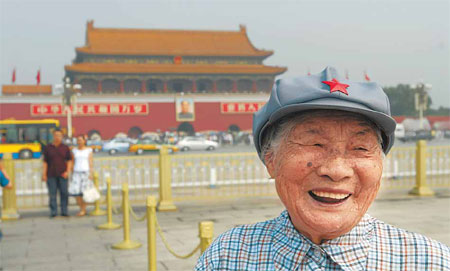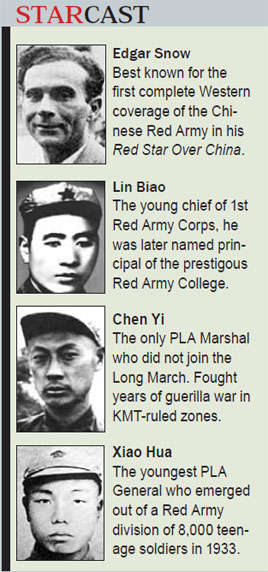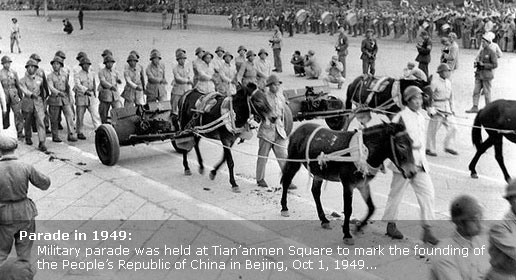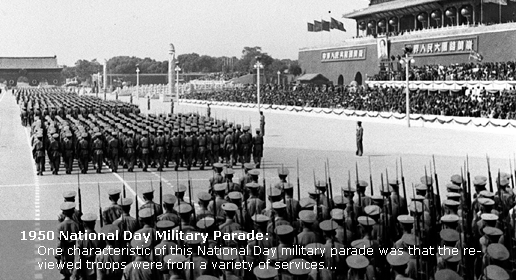60 People, 60 Stories
Blood lines
By Wang Ru (China Daily)
Updated: 2009-09-30 07:42

| ||||
She was born into an impoverished family in Bazhong county of Sichuan province, the youngest girl in a big family. Her life was a wretched one filled with famine, disease and abusive landlords.
One freezing winter's day, the 4-year-old Pu and her elder sister warmed themselves by a fire used for boiling salt in their landlord's yard. When the man discovered the sisters, he became furious and kicked them into the fire. Pu still has the burn scars to show.
 When Pu was 14, a group of guerilla soldiers set up camp in her hometown. They called themselves the "Workers' and Peasants' Red Army" that worked toward liberating poor people such as herself.
When Pu was 14, a group of guerilla soldiers set up camp in her hometown. They called themselves the "Workers' and Peasants' Red Army" that worked toward liberating poor people such as herself.
Pu was skeptical of them and warily watched those soldiers, who wore caps with red stars. But it was not long before she saw how differently they treated the poor from the landlords.
In September 1933, Pu joined the Fourth Army division of the Red Army and became a nurse. The following July, she became part of the Long March - a journey covering more than 10,000 km in 742 days.
During the March, Pu was suffering from a serious eye affliction at the foot of an over 4,000-m high mountain they had to climb in Sichuan. She could barely see anything but still insisted on taking care of Song Yimin, a seriously wounded commander.
With five other teenage nurses, Pu carried Song on a stretcher through hail and blizzards. They were exhausted but had to move on, because stopping meant they would freeze to death.
As they trudged up mountains, a raging thunderstorm struck and thick hail fell on them.
After the squall passed, they realized Song, whom they tried all means to save, had died.
Pu says she still remembers Song's final words: "You have finished your mission; head to our victory."
She kept those words close to her heart for the rest of the march, devoting herself to others across mountains and marshland.
In a ceremony held in Beijing last year to celebrate the 70th anniversary of the Long March, Pu, wearing a Red Army uniform, narrated her experience.
She said it taught her the meaning of dedication, a virtue that stays with her today.
"It is the soul of our nation; we should never forget the 200,000 soldiers who sacrificed their lives to fight for liberation," Pu says.
In the following War of Resistance against Japanese Aggression from 1937-45, Pu worked with her comrades in Yan'an, Shaanxi province.
In 1937, Pu joined the CPC and in 1939 married He Bingwen, a transportation officer in Yan'an. They had two daughters and five sons, all of whom became soldiers and members of the CPC.
After the founding of the People's Republic of China, Pu worked in the transportation department.
Her children and grandchildren continue her attitude toward life: "Life is enriched not by what you get, but by what you give."
Time Line
Aug 1, 1927
The predecessor of the People's Liberation Army is formed. It is known as the Chinese Workers' and Peasants' Red Army.
1930-34
The Red Army repels four successive campaigns by Kuomintang troops but loses in the fifth.
October 1934
The Long March begins. The strategic retreat of all Red Army troops is not complete until Oct 22, 1936, when the three forces link up in Yan'an, Shaanxi province.
1937-1945
The Red Army forces are integrated into the National Revolution Army, forming the Eighth Route Army and the New Fourth Army. The latter becomes active south of the Yangtze River while the former is based in the northwest.
1945-1949
The CPC merges its two military groups and renames the multi-million strong force the People's Liberation Army, and liberates the Chinese mainland.
1955
222 of the 245 senior PLA leaders conferred the ranks of lieutenant-general and above were part of the Long March.
2004
Nearly 80,000 former Red Army soldiers are still alive.








